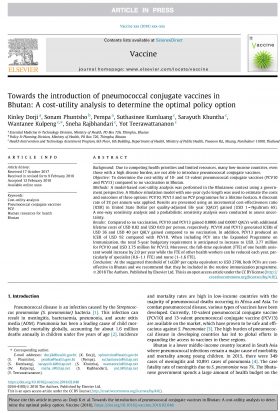This website uses cookies so that we can provide you with the best user experience possible. Cookie information is stored in your browser and performs functions such as recognising you when you return to our website and helping our team to understand which sections of the website you find most interesting and useful.
Towards the introduction of pneumococcal conjugate vaccines in Bhutan: A cost-utility analysis to determine the optimal policy option

Details
Abstract
Background
Due to competing health priorities and limited resources, many low-income countries, even those with a high disease burden, are not able to introduce pneumococcal conjugate vaccines.
Objective
To determine the cost-utility of 10- and 13-valent pneumococcal conjugate vaccines (PCV10 and PCV13) compared to no vaccination in Bhutan.
Methods
A model-based cost-utility analysis was performed in the Bhutanese context using a government perspective. A Markov simulation model with one-year cycle length was used to estimate the costs and outcomes of three options: PCV10, PCV13 and no PCV programmes for a lifetime horizon. A discount rate of 3% per annum was applied. Results are presented using an incremental cost-effectiveness ratio (ICER) in United State Dollar per quality-adjusted life year (QALY) gained (USD 1 = Ngultrum 65). A one-way sensitivity analysis and a probabilistic sensitivity analysis were conducted to assess uncertainty.
Results
Compared to no vaccination, PCV10 and PCV13 gained 0.0006 and 0.0007 QALYs with additional lifetime costs of USD 0.02 and USD 0.03 per person, respectively. PCV10 and PCV13 generated ICERs of USD 36 and USD 40 per QALY gained compared to no vaccination. In addition, PCV13 produced an ICER of USD 92 compared with PCV10. When including PCV into the Expanded Programme on Immunization, the total 5-year budgetary requirement is anticipated to increase to USD. 3.77 million for PCV10 and USD 3.75 million for PCV13. Moreover, the full-time equivalent (FTE) of one health assistant would increase by 2.0 per year while the FTE of other health workers can be reduced each year, particularly of specialist (0.6–1.1 FTE) and nurse (1–1.6 FTE).
Conclusion
At the suggested threshold of 1xGDP per capita equivalent to USD 2708, both PCVs are cost-effective in Bhutan and we recommend that they be included in the routine immunization programme.
Click here to access the publication: 10.1016/j.vaccine.2018.02.048




